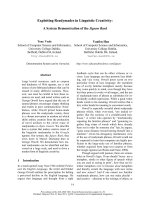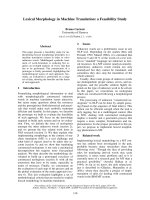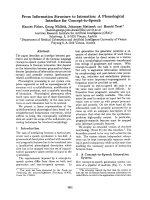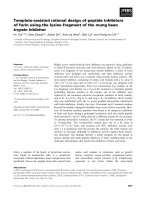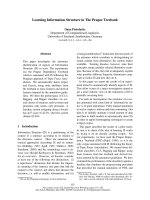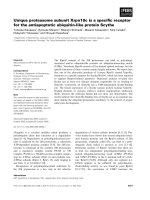Báo cáo khoa học: " Patient information in radiation oncology: a cross-sectional pilot study using the EORTC QLQ-INFO26 module" ppsx
Bạn đang xem bản rút gọn của tài liệu. Xem và tải ngay bản đầy đủ của tài liệu tại đây (469.59 KB, 7 trang )
BioMed Central
Open Access
Page 1 of 7
(page number not for citation purposes)
Radiation Oncology
Research
Patient information in radiation oncology: a cross-sectional
pilot study using the EORTC QLQ-INFO26 module
Johannes Adler*
1
, Yvonne Paelecke-Habermann
2
, Patrick Jahn
3
,
Margarete Landenberger
3
, Bernd Leplow
2
and Dirk Vordermark
1
Address:
1
Department of Radiation Oncology, Martin Luther University Halle-Wittenberg, Halle/Saale, Germany,
2
Department of Psychology,
Martin Luther University Halle-Wittenberg, Halle/Saale, Germany and
3
Institute of Nursing and Health Science, Martin Luther University Halle-
Wittenberg, Halle/Saale, Germany
Email: Johannes Adler* - ; Yvonne Paelecke-Habermann - ;
Patrick Jahn - ; Margarete Landenberger - ;
Bernd Leplow - ; Dirk Vordermark -
* Corresponding author
Abstract
Background: The availability of alternative sources of information, e. g. the internet, may influence
the quantity and quality of information cancer patients receive regarding their disease and
treatment. The purpose of the present study was to assess perception of information in cancer
patients during radiotherapy as well as media preferences and specifically the utilization of the
internet.
Methods: In a cross-sectional, single-centre study 94 patients currently undergoing radiotherapy
were asked to complete two questionnaires. The EORTC QLQ-INFO26 module was used to
assess the quality and quantity of information received by patients in the areas disease, medical
tests, treatment, other services, different places of care and how to help themselves, as well as
qualitative aspects as helpfulness of and satisfaction with this information. The importance of
different media, in particular the internet, was investigated by a nine-item questionnaire.
Results: The response rate was n = 72 patients (77%). Patients felt best informed concerning
medical tests (mean ± SD score 79 ± 22, scale 0-100) followed by disease (68 ± 21). Treatment (52
± 24) and different places of care and other services (30 ± 36 and 30 ± 30, respectively) ranked
last. 37% of patients were very satisfied and 37% moderately satisfied with the amount of
information received, 61% wished more information. Among eight media, brochures, television and
internet were ranked as most important. 41% used the internet themselves or via friends or family,
mostly for research of classic and alternative treatment options. Unavailability and the necessity of
computer skills were most mentioned obstacles.
Conclusion: In a single-center pilot study, radiotherapy patients indicated having received most
information about medical tests and their disease. Patients very satisfied with their information had
received the largest amount of information. Brochures, television and internet were the most
important media. Individual patient needs should be considered in the development of novel
information strategies.
Published: 28 September 2009
Radiation Oncology 2009, 4:40 doi:10.1186/1748-717X-4-40
Received: 10 August 2009
Accepted: 28 September 2009
This article is available from: />© 2009 Adler et al; licensee BioMed Central Ltd.
This is an Open Access article distributed under the terms of the Creative Commons Attribution License ( />),
which permits unrestricted use, distribution, and reproduction in any medium, provided the original work is properly cited.
Radiation Oncology 2009, 4:40 />Page 2 of 7
(page number not for citation purposes)
Background
Patient information in oncology has recently received
increasing attention. Providing adequate information to
the cancer patient can reduce anxiety and improve com-
pliance of the patient [1]. Information disclosure adapted
to the individual needs of each patient can facilitate
patient-physician communication to enable informed
decisions [2] and increase patient satisfaction [3]. Despite
present efforts to improve cancer patient information,
recent studies reported between 10 and 28% of patients
not satisfied with the information [4,5]. Whereas several
studies investigated the amount and content of informa-
tion [6], others focused on its influence on quality of life
[7].
From the physician's perspective, the information needs
of an individual cancer patient may not always be easily
detectable [8]. One finding in published studies was that
patients wanted as much information as possible [9,10].
On the other hand, satisfaction with the information pro-
vided may be more relevant for the quality of life of an
individual cancer patient than the mere quantity of infor-
mation [7].
New media have been introduced for providing informa-
tion to cancer patients. Written information supplied rou-
tinely during doctor consultation has been supplemented
by interactive DVDs [11] and audiotapes of the consulta-
tion [12]. The internet is gaining more importance as a
source of information for cancer patients [13-16].
The aim of the present study was to evaluate the percep-
tion of cancer patients undergoing radiotherapy regarding
the information received on different areas of the disease,
diagnosis, treatment and care and the importance of dif-
ferent media, especially the internet.
Methods
We conducted a cross-sectional observational study at a
single center to generate hypotheses for future larger-scale
studies of patient information in cancer patients. We now
included cancer patients undergoing radiotherapy at the
Department of Radiation Oncology, Martin Luther Uni-
versity Halle-Wittenberg, Germany, in November 2008.
All patients on treatment were eligible regardless of age,
tumor entity or type of radiotherapy. Signed written
informed consent was obtained. Patients were excluded if
they were considered by the treating physicians to be una-
ble to participate due to very poor general condition
(ECOG = 4) or severe mental impairment. The study was
approved by the local ethics committee.
Standard information handed out to patients at the Dept.
of Radiation Oncology at the time of the study was the
information part of the informed consent form. Free bro-
chures from the German Cancer Aid (Deutsche Kreb-
shilfe) were available in the waiting areas. Other sources
of information were not routinely recommended.
The utilized INFO26 questionnaire of the EORTC [17,18]
consists of 26 items organized in four scales on informa-
tion about the disease (four items), about medical tests
(three items), about treatment (seven items), about other
services (four items) and of four single items on informa-
tion in other areas as well as four items on qualitative
aspects (e. g. satisfaction with amount of information,
helpfulness of information). Two of the items on infor-
mation in other areas asked if the patients had received
written information or information on CD (yes/no). For
quantitave questions, patients were asked to indicate if
they received no, little, moderate or very much informa-
tion on a particular subject. The answers for multi-item
scales or individual items were linearly transformed to a 0-
100 scale, a high score equaling a high level of informa-
tion. The INFO26 questionnaire was designed and evalu-
ated by the EORTC Quality of Life Group following a strict
procedure established for module development, as
described previously [17,18].
Data on the use of the internet as a source of medical
information, main topics of interest and the importance
of various media were collected by a previously used nine-
item-questionnaire [19]. Eight possible media (television,
patient brochure, newspaper, medical books, magazines,
"waiting-room chat", patient-support groups and inter-
net) were ranked from "unimportant" (0) to "very impor-
tant" (2) as sources of medical information. If a specific
medium was not rated by the patient, this medium was
scored as "unimportant" (0).
For each scale or item of EORTC QLQ-INFO26 and for
each medium, the mean and SD scores were calculated for
the overall group and subgroups.
Results
Of the overall group of n = 94 patients, those with very
poor general condition or severe mental problems (n =
19) were excluded from the analysis. Of the remaining 75
patients three declined participation and 72 completed
the questionnaire. Descriptive characterization of the
patient cohort is presented in Table 1.
Figure 1 depicts scales of the INFO26 questionnaire repre-
senting the quantity of information received by patients
about the disease, medical tests, medical treatment, other
services, different places of care and how to help them-
selves. High values represent a large amount of informa-
tion received (maximum score 100). The mean scores
range from 79 ± 22 (medical tests) to 30 ± 30 and 30 ± 36
Radiation Oncology 2009, 4:40 />Page 3 of 7
(page number not for citation purposes)
("other services" and "different places of care", respec-
tively). Most information was received about the purpose,
results and procedure of the medical tests, followed by
information on diagnosis, spreading and possible causes
of the disease and whether it is under control ("diagno-
sis"). Information related to medical treatment was rated
forth. Less information had been received in the area
"other services" (including information on patient sup-
port groups, nursing at home, rehabilitation, coping with
the disease at home and psychological support) and the
item "different places of care" (referring to other hospital,
nursing services and nursing home).
Most patients were moderately to very satisfied (74%)
with the amount of information about their medical
issues (Figure 2). However, 61% of participants indicated
that they wished more information. Topics of additional
information mentioned by the patients in response to an
open question for instance were further therapies, alterna-
tive treatment, nutrition and chance of cure. On the other
hand, 6% of patients wanted less information. 50% of
patients found the information they received as overall
helpful and 6% as not helpful. Table 2 displays the differ-
ences in amount of information received in subgroups
with different levels of satisfaction, showing that very sat-
isfied patients had received more information than less
satisfied patients.
The importance of eight possible media (brochures, tele-
vision, newspapers, magazines, internet, medical books,
self-support-groups and waiting-room chat) was ranked
by the cancer patients on a scale from 0 (not important)
to 2 (very important) (Figure 3). The three most impor-
tant media were brochures (0.89 ± 0.93), television (0.72
± 0.86) and internet (0.52 ± 0.84). Self-support groups
ranked last.
41% of patients indicated having obtained information
about the disease by the help of the internet. 83% were
familiar with the term 'internet' and 73% knew about the
possibility of searching information on it. Main topics
were classic treatment modalities (surgery, chemo- and
radiation therapy) and alternative treatment options.
However only 39% of internet users discussed details of
information gained from the internet with their physi-
cian. The lack of sufficient computer literacy (26%) and
the availability of a computer (51%) were the most fre-
quently mentioned obstacles to using the internet for
information.
Figure 4 shows the percentage of internet use in patient
subgroups by tumor entity, education, sex and age. High
educational status, female sex and younger age were asso-
ciated with a higher rate of internet use. Rectal and ear,
Table 1: Characteristics of n = 72 tumor patients (ENT: ear, nose and throat)
overall cohort n = 72
n%
diagnosis ENT 15 21
uterus 34
brain 68
rectal 811
lung 811
esophagus/gastric 34
breast 13 18
prostate 68
lymphoma 57
brain metastasis 11
others 46
sex male 43 60
female 29 40
age <30 46
40-49 10 14
50-59 18 25
60-69 19 26
>69 21 29
education basic ("Volkschule/Hauptschule") 28 39
intermediate("Mittlere Reife") 22 31
high("Abitur") 46
university degree 811
Radiation Oncology 2009, 4:40 />Page 4 of 7
(page number not for citation purposes)
nose and throat (ENT) cancer patients used the internet
less frequently than brain tumor or lymphoma patients.
Discussion
In the present cross-sectional pilot study, patients consid-
ered the received information overall helpful, even if there
were still some topics partly unadressed. This concerns
information about rehabilitation, self-support-groups,
rehabilitation and psychological services and diverse out-
patient nursing services. Comparison of satisfaction with
amount of information suggested that the two are associ-
ated and that there may be a threshold level of informa-
tion quantity that should be achieved in a clinical setting.
There appears to be no need in reaching the maximum
quantity of information, as patients already felt very satis-
fied at mean scores of 82 for disease, 92 for medical tests,
73 for treatment, 51 for other services, 58 for different
place of care and 82 for help at home (Table 1).
It remains unclear whether the less satisfied patients did
not receive sufficient information or the patients lost
information, due limited capacity and the enormous
amout of information as Sadler et al showed previously
[20].
We could not detect one specific medium that is particu-
larly suitable for filling gaps of information. The internet
is increasingly accepted as a source of medical informa-
tion [13-16] and is now a major source of patient infor-
mation (Table 3). However, in the majority of patients the
information received via the internet is not communi-
Amount of information received by cancer patients undergoing radiotherapy on a scale from 0 to 100 (mean ± SD) concerning information about the disease, medical tests and treatment, about other services (e. g. physiotherapy), different places of care and about information to help themselves at home, as assessed by EORTC QLQ-INFO26 module (score of 100: maximum amount of information received)Figure 1
Amount of information received by cancer patients undergoing radiotherapy on a scale from 0 to 100 (mean ±
SD) concerning information about the disease, medical tests and treatment, about other services (e. g. physio-
therapy), different places of care and about information to help themselves at home, as assessed by EORTC
QLQ-INFO26 module (score of 100: maximum amount of information received).
0
10
20
30
40
50
60
70
80
90
100
110
disease m edical tests m edical
treatm ent
other services different
places of care
self help
Table 2: Amount of information (100: max. amount) by satisfaction with information
amount of information
(mean ± SD score)
satisfaction with amount of information disease medical
tests
treatment other services different places of care self-help
very satisfied 83 ± 16 92 ± 19 73 ± 14 51 ± 30 58 ± 37 82 ± 26
moderately, less satisfied and very
unsatisfied
61 ± 20 70 ± 20 41 ± 20 19 ± 23 15 ± 25 41 ± 30
overall group 68 ± 21 78 ± 22 53 ± 24 30 ± 30 30 ± 36 56 ± 35
Radiation Oncology 2009, 4:40 />Page 5 of 7
(page number not for citation purposes)
cated to the physician. Matthews et al. [21] give cause for
serious concern, because online medical information is
unregulated and of questionable accuracy.
Considering the average age of cancer patients (69 years at
first diagnosis in Germany), the applicability of the inter-
net to provide information to cancer patients is currently
still limited by the necessity of computer skills. In less
educated and older groups of patients, who showed the
lowest rates of internet use in this study, alternative media
should be considered.
The quantity and quality of information offered at cancer
centers and the potential of new information strategies to
influence the satisfaction of patients with the received
information as well as their anxiety and compliance
should be investigated in further studies. Some new
media have been introduced as part of trials, but are not
yet routinely available at German radiotherapy centers.
However it remains unclear which information models
are capable of fulfilling the needs of various types of
patients and relatives. Passalacqua et al. [5] hypothesized
that a structured modality of providing information
reduces psychological distress and performed a two-arm,
cluster-randomized trial implementing a point of infor-
mation and support in oncology wards. It was realized by
a library for cancer patients managed by a specially trained
oncology nurse. End points were reduction of anxiety and
depression of cancer patients. This approach did not lead
to a significant reduction in anxiety and depression. Com-
pliance was low, in more than 50% of the participating
centers the library did not follow the protocol, mostly
because of conflicts of staff.
Several methodological aspects of our study deserve fur-
ther discussion. This trial assessed in a cross-sectional
design the perception of information regarding the infor-
Eight possible information media and their mean ± SD importance ranked by cancer patients undergoing radiotherapy from unimportant (0) to very important (2)Figure 3
Eight possible information media and their mean ± SD importance ranked by cancer patients undergoing radi-
otherapy from unimportant (0) to very important (2). Data are displayed as mean ± SD scores.
brochures
television
internet
waiting room chat
magazines
newspaper
medical books
patient-support
groups
Percentage of cancer patients undergoing radiotherapy stat-ing that they are very unsatisfied, less, moderately or very satisfied with the amount of information received, as assessed by EORT QLQ-INFO26 moduleFigure 2
Percentage of cancer patients undergoing radiother-
apy stating that they are very unsatisfied, less, mod-
erately or very satisfied with the amount of
information received, as assessed by EORT QLQ-
INFO26 module.
%
%
Radiation Oncology 2009, 4:40 />Page 6 of 7
(page number not for citation purposes)
mation received on different areas of the disease, diagno-
sis, treatment and care and the importance of different
media, especially the internet in the distinct group of can-
cer patients undergoing radiotherapy. We used with
EORTC QLQ-INFO26 a tested and multi-language ques-
tionnaire, and collected comparable and generalisable
data. However, several limitations of this trial should be
noted. First of all this was a single-centre study and the
results are only representative for the region of Southern
Saxony-Anhalt, a region about 1.2 million inhabitants.
The perception of information received may vary during a
course of radiotherapy and future studies should aim to
assess patients at defined timepoints before, during or
after treatment.
Future trials should use information disclosure adapted to
the patients' characteristics and needs, not neglecting that
there are also patients wanting less information. For
Table 3: Importance of media for cancer patients as ranked in published studies
Vordermark
2000 [19]
Schäfer
2002 [22]
Peterson
2003 [15]
Basch
2004 [16]
Adler
[this study]
setting radiation oncology
center
radiation oncology
center
lung cancer center cancer center radiation oncology
center
internet 85323
doctor -11+2
self-support group 7 8
TV 137-2
newspaper 33-16
brochures 2 11
medical book 42517
Waiting-room chat 6 4
telephone 3-
family 4
radio -5
magazine 53615
Frequency in percent of internet use among subgroups of cancer patients undergoing radiotherapyFigure 4
Frequency in percent of internet use among subgroups of cancer patients undergoing radiotherapy.
Publish with BioMed Central and every
scientist can read your work free of charge
"BioMed Central will be the most significant development for
disseminating the results of biomedical research in our lifetime."
Sir Paul Nurse, Cancer Research UK
Your research papers will be:
available free of charge to the entire biomedical community
peer reviewed and published immediately upon acceptance
cited in PubMed and archived on PubMed Central
yours — you keep the copyright
Submit your manuscript here:
/>BioMedcentral
Radiation Oncology 2009, 4:40 />Page 7 of 7
(page number not for citation purposes)
instance, different media should be employed to reach a
head and neck cancer patient than to address a brain
tumor patient. It appears promising to integrate individ-
ual patient counseling and structured patient information
provided via suitable media into comprehensive patient
information strategies. In larger studies, instruments like
INFO26 can help to identify the information needs of
subgroups with specific tumor types.
Conclusion
In a single-center pilot study, radiotherapy patients indi-
cated having received most information about medical
tests and their disease, less about the medical treatment or
other areas. Patients very satisfied with their information
had received the largest amount of information. Bro-
chures, television and internet were the three most impor-
tant media. Information needs of patients differ between
tumor entities which should be considered in the devel-
opment of novel information strategies.
Competing interests
The authors declare that they have no competing interests.
Authors' contributions
JA participated in the study design, collected the data, per-
formed the data analysis and drafted the manuscript. YPH
participated in the study design, performed the data anal-
ysis and helped to draft the manuscript. PJ participated in
the study design, performed the data analysis and helped
to draft the manuscript. ML participated in the study
design and helped to draft the manuscript. BL participated
in the study design and helped to draft the manuscript.
DV participated in the study design, collected the data,
performed the data analysis and helped to draft the man-
uscript. All authors read and approved the final manu-
script.
References
1. Butow PN, Kazemi JN, Beeney NJ, Griffin AM, Dun SM, Tattersall MH:
When the diagnosis is cancer: patient communication expe-
riences and preferences. Cancer 1996, 77:2630.77.
2. Arraras JL, Illaramendi JJ, Valerdi JJ, Wright S: Truth telling to the
patient in advanced care: family information filtering and
prospects for change. Psychooncology 1995, 4:191-196.
3. Degner LF, Davison BJ, Sloan JA, Mueller B: Development of a
scale to measure information needs in cancer care. J Nurs
Meas 1998, 6:137-53.
4. Montomery C, Lydon A, Lloyd K: Psychological Distress among
cancer patients and informed consent. J Psychosom Res 1999,
46:241-245.
5. Passalacqua R, et al.: Prospective, multicenter, randomized trial
of a new organizational modality for providing information
and support to cancer patients. J clinical Oncol 2009, 27:1-5.
6. Butow PN, Kazemi JN, Beeney NJ, Griffin AM, Dun SM, Tattersall MH,
Boyer MJ: The dynamics of change: cancer patient's prefer-
ences for information involvement and support. Ann Oncol
1997, 8:857-63.
7. Annunziata MA, Foladore S, Margi MD, Crivellari D, Feltrin A, Bidoli
E, Veronesi A: Does information level of cancer patients cor-
relate with quality of life? A prospective study. Tumori 1998,
84:619-23.
8. Blanchard CG, Labreque MS, Ruckdeschel JC, Blanchard EB: Infor-
mation and decision-making preferences of hospitalized can-
cer patients. Soc Sci Med 1988, 27:1139-45.
9. Gysels M, Higginson IJ: Interactive technologies and videotapes
for patient education in cancer care: systematic review and
meta-analysis of randomized trials. Support Care Cancer 2007,
15:7-20.
10. Fallowfield l, Lord S, Lewis S: No news is not good news: infor-
mation preferences of patients with cancer. Psychooncology
1995, 4:197-202.
11. Strevel EL, Newman C, Pond GR, MacLean M, Siu LL: The impact
of educational DVD on cancer patients considering partici-
pation in a phase I clinical trial. Support Care Cancer 2007,
15:829-840.
12. Brucera E, Pituskin E, Calder K, Neumann CM, Hanson J: The addi-
tion of an audiocassette recording of a consultation to writ-
ten recommendations for patients with advanced caner: a
randomized trial. Cancer 1999, 86:2420-2425.
13. Van de Poll-Franse L, van Ellenbergen MC: Internet use by cancer
survivors: current use and future wishes. Support Care Cancer
2007.
14. Chen X, Siu LL: Impact of the media and the internet on oncol-
ogy: survey of cancer patients and oncologists in Canada. J
Clin Oncol 2001, 19(23):4291-4297.
15. Peterson MW, Fretz PC: Patient Use of the Internet for Infor-
mation in a Lung Cancer Clinic. Chest 2003, 123:452-457.
16. Basch EM, Thaler HT, Shi W, Yakren S, Schrag D: Use of informa-
tion resources by patients with cancer and their compan-
ions. American Cancer Society 2004:2476-2483.
17. Arraras JI, et al.: EORTC QLQ-INFO 26: A questionnaire to
assess information given to cancer patients a preliminary
analysis in eight countries. Psycho-Oncology 2007, 16:249-254.
18. Arraras JI, Wrigth S, Greimel E, Holzner B, Kuljanic-Vlasic K, Velikova
G, Eisemann M, Visser A: Development of a questionnaire to
evaluate the information needs of cancer patients: the
EORTC questionnaire. Patient education and Counseling 2004,
54:235-241.
19. Vordermark D, Kolbl O, Flentje M: The internet as a source of
medical information: investigation in a mixed cohort of radi-
otherapy patients. Strahlenther Onkol 2000, 176:532-535.
20. Sadler GR, Oberle-Edwards L, Farooqi A, Hryniuk WM: Oral seque-
lae of chemotherapy: an important teaching opportunity for
oncology health care providers and their patients. Support
Care Cancer 2000, 8:
209-14.
21. Matthews SC, Camacho A, Mills PJ, Dimsdale JE: The internet for
medical information about cancer. Help of hindrance? Psycho-
somatics 2003, 44:100-103.
22. Schäfer C, Dietl B, Putnik K, Altmann D, Marienhagen J, Herbst M:
Patient information in Radiooncology. Strahlenther Onkol 2002,
10:562-571.


